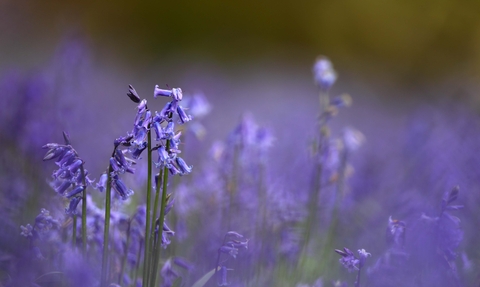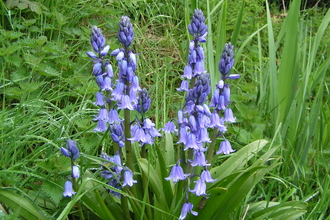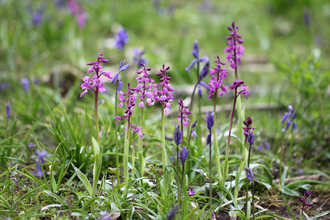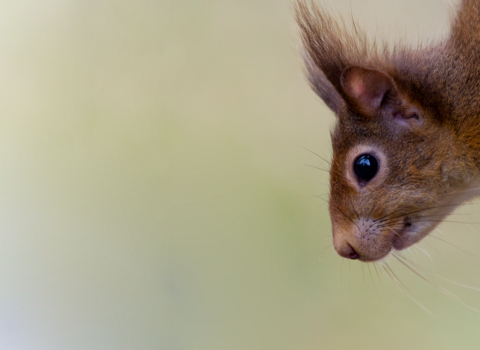
©Luke Massey/2020VISION
Where to see bluebells
Bluebell woods
Over the space of a few weeks in spring, from mid-April onwards, bluebells set our woodlands ablaze with their bright blue flowers. The UK is home to more than half the world’s population of bluebells, making it our unofficial national flower. Their presence is a sure sign you are in a very old woodland.
The Wildlife Trusts care for hundreds of woodlands and look after some of the finest displays of bluebells in the country.
Find a bluebell wood near you
Do a little research in advance and find out where your nearest ancient woodland is. Below you can find a list of more than 100 Wildlife Trust bluebells woods, all free to enter.
North
- Cheshire: Warburton’s Wood, Poors Wood, Pumphouse Wood, Marbury Reedbed, Owley Wood, Swettenham Meadows & the Quinta
- Cumbria, Barkbooth Lot, Dorothy Farrer's Spring Wood
- Durham, Baal Hill Wood, High Wood
- Lancashire: Aughton Woods, Boilton Wood
- Sheffield, Moss Valley Woodlands, Greno Woods
- Tees Valley: Saltburn Gill, Lazenby Bank
- Yorkshire: North Cliffe Wood, Garbutt Wood, Stoneycliffe Wood, Hetchell Wood
Midlands
- Birmingham: Moseley Bog, Hill Hook
- Derbyshire: Mapperley Wood
- Herefordshire: Lea & Paget's Wood,
- Leicestershire: Prior's Coppice, Launde Woods
- Lincolnshire: Rigsby Wood, Dole Wood, Tortoiseshell Wood
- Northamptonshire: Old Sulehay, Short Wood
- Nottinghamshire: Bunny Wood, Ploughman Wood
- Shropshire: Earl’s Hill, The Ercall, Hope Valley
- Staffordshire: Parrot’s Drumble, George’s Hayes, Hem Heath Woods, Cotton Dell
- Warwickshire: Wappenbury Wood, Crackley Wood, Hampton Wood, Rough Hill Wood
- Worcestershire: Chaddesley Woods, Trench Wood
South
- Berkshire: Bowdown Woods, Moor Copse
- Bristol: Prior’s Wood, Folly Farm
- Buckinghamshire: Dancersend, Finemere Wood, Rushbeds Wood
- Devon, Emsworthy, Andrew's Wood, Dunsford, Lady's Wood, New England Wood, Halsdon, Scanniclift Copse
- Dorset: Hibbit Woods, Powerstock Common, Bracketts Coppice, Ashley Wood
- Gloucestershire, Siccaridge Wood, Lower Woods
- Hampshire: Roydon Woods
- Hertfordshire: Tewin Orchard and Hopkyns Wood, Gobions Wood
- Isle of Wight: Eaglehead and Bloodstone Copse
- Kent: Parsonage Wood
- London: Gutteridge Wood, Sydenham Hill Wood
- Oxfordshire: Foxholes, Sydlings Copse
- Somerset: Long Wood (Cheddar Complex)
- Surrey: Chinthurst Hill, Cucknells Wood
- Sussex: Selwyn's Wood
- Wiltshire: Hagbourne Copse, Clouts Wood, Blackmoor Copse, Hankerton Copse at Cloatley Meadows, Malmesbury, Vincients Wood, Chippenham
East
- Bedfordshire: Landpark Wood
- Cambridgeshire: Hayley Wood, Hardwick Wood, Waresley and Gransden Woods, Thorpe Wood, Gamlingay Wood, Brampton Wood, Lady's Wood
- Essex: Pound Wood, Weeleyhall Wood, Hanningfield Reservoir, Shut Heath Wood, Bedfords Park
- Hertfordshire: Old Park Wood
- Norfolk: Foxley Wood, Lower Wood, Wayland Wood
- Suffolk: Arger Fen, Bradfield Woods, Captain's Wood, Groton Wood, Reydon Wood
Wales
- Carmarthenshire, Dinefwr Castle Woods
- Montgomeryshire: Coed Pendugwm
- Radnorshire: Gilfach Nature Reserve
- Gwent, Prisk Wood, Croes Robert Wood
Scotland
- Argyll and Bute: Shian Wood
- Lanarkshire: Cumbernauld Glen
- Dumfriesshire: Carstramon Wood
Northern Ireland
- Northern Ireland: Straidkilly, Glenarm
Islands
- Alderney: Vau Du Saou
What to look for
Bluebells are the start of the show in springtime woodlands but there's lots more to see and hear too. Listen out for woodland birds singing from the branches. Many bluebells woods will be home to birds that have migrated thousands of miles to the UK to breed like the blackcap, wood warbler, nightingale and chiffchaff. On the ground look for other woodland wildflowers among the bluebells like the delicate white stars of stitchwort and the unmissable pink spikes of early purple orchids. Remember it’s not just about the colour. The flowers have a distinctive if subtle sweet scent: get down amongst the nodding flower heads and take a deep sniff too!
If you can't get to a bluebell wood
If you can't get to an old woodland look out for bluebells growing in road verges, in small patches of woodland and in parks and gardens in April and May. But outside ancient woodlands you might be looking at spanish bluebells which are subtly different to our native english bluebells and can be found in parks and gardens.
More wildlife experiences
From seeing colourful wildflowers to spotting magnificent birds of prey, we can help you get closer to wildlife across the UK.






